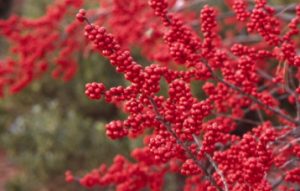Bulletin #2571, Native Trees and Shrubs for Maine Landscapes: Winterberry (Ilex verticillata)
Developed by Marjorie Peronto, Associate Extension Professor, University of Maine Cooperative Extension; and Reeser C. Manley, Assistant Professor of Horticulture, University of Maine.
For information about UMaine Extension programs and resources, visit extension.umaine.edu.
Find more of our publications and books at extension.umaine.edu/publications/.
Go native!
This series of publications is the result of a five-year research project that evaluated the adaptability of a variety of native trees and shrubs to the stresses of urban and residential landscapes in Maine. Non-native invasive plants pose a serious threat to Maine’s biodiversity. Plants such as Japanese barberry, shrubby honeysuckle, and Asiatic bittersweet, originally introduced for their ornamental features, have escaped from our landscapes, colonizing natural areas and displacing native plants and animals. By landscaping with native plants, we can create vegetation corridors that link fragmented wild areas, providing food and shelter for the native wildlife that is an integral part of our ecosystem. Your landscape choices can have an impact on the environment that goes far beyond your property lines.
Description
Form: a multi-stemmed shrub with dense, slender, upright, spreading branches; often forms thickets
Size: 6 to 12 feet tall with a similar spread
Ornamental characteristics:
- bright red berries on dark gray, leafless stems are a focal point in the winter landscape
Landscape Use
Winterberry is an excellent choice for those spring-flooded sites that become dry in summer. It will tolerate both extremes of soil moisture, once established. Plant it with other native shrubs that will tolerate such conditions, including buttonbush (Cephalanthus occidentalis), steeplebush (Spiraea tomentosa), and red osier dogwood (Cornus sericea).
Alternatively, consider using winterberry as an informal hedge behind the garden border, where its lustrous green foliage will be a handsome foil for summer flowers. The bright red berries of female plants will take center stage in winter if you plant a male or two nearby.
Culture
Hardiness: USDA zone 3b
Soil requirements: tolerant of wet soils
Light requirements: sun or part shade
Stress tolerances:
soil compaction — tolerant
pollution — somewhat tolerant
deicing salts — intolerant
urban heat islands — intolerant
drought — tolerant once established
seasonal flooding — very tolerant
Insect and disease problems: infrequent
Wildlife Value
The berries of winterberry are devoured by 49 species of birds, including songbirds, winter waterfowl, and game birds. Frequent songbird consumers include eastern bluebirds, hermit and wood thrushes, American robins, catbirds, northern mockingbirds, brown thrashers, cedar waxwings, and white-tailed sparrows. Because the berries are relatively low in fat content, they are often taken late in the winter when other fruits are scarce. This translates into a longer period in which we can enjoy the ornamental beauty of these winter fruits.
Raccoons and white-footed mice enjoy the fruits and seeds. Thoreau observed the mice, writing that they “run up the twigs at night and gather this shining fruit, take out the small seeds, and eat their kernels at the entrance to their burrows.”*
Deer also browse twigs and foliage of young plants.
Maintenance
Irrigation: Water shrubs regularly for at least one year after planting. Apply 1 inch of water over the root zone once a week until leaves fall in autumn: in general, a shrub’s root zone extends twice as wide as its canopy. Once established, further watering should not be necessary unless there are extended periods of drought.
Fertilization: Landscape trees and shrubs should not be fertilized unless a soil test indicates a need. Correct soil pH, if necessary, by amending the backfill soil. No nitrogen fertilizer should be added at planting or during the first growing season.
To learn more about native woody plants
Visit the Eastern Maine Native Plant Arboretum at University of Maine Cooperative Extension’s Penobscot County office, 307 Maine Avenue in Bangor. Established in 2004, the arboretum displays 24 different native tree and shrub species that can be used in managed landscapes.
Reviewed by Cathy Neal, Extension professor, University of New Hampshire Cooperative Extension.
Photos by Reeser C. Manley.
Illustration by Margery Read, Extension Master Gardener.
This series of publications and the associated research were made possible in part by the Maine Forest Service’s Project Canopy.
Information in this publication is provided purely for educational purposes. No responsibility is assumed for any problems associated with the use of products or services mentioned. No endorsement of products or companies is intended, nor is criticism of unnamed products or companies implied.
© 2008
Call 800.287.0274 (in Maine), or 207.581.3188, for information on publications and program offerings from University of Maine Cooperative Extension, or visit extension.umaine.edu.
In complying with the letter and spirit of applicable laws and pursuing its own goals of diversity, the University of Maine System does not discriminate on the grounds of race, color, religion, sex, sexual orientation, transgender status, gender, gender identity or expression, ethnicity, national origin, citizenship status, familial status, ancestry, age, disability physical or mental, genetic information, or veterans or military status in employment, education, and all other programs and activities. The University provides reasonable accommodations to qualified individuals with disabilities upon request. The following person has been designated to handle inquiries regarding non-discrimination policies: Director of Institutional Equity and Title IX Services, 5713 Chadbourne Hall, Room 412, University of Maine, Orono, ME 04469-5713, 207.581.1226, TTY 711 (Maine Relay System).






